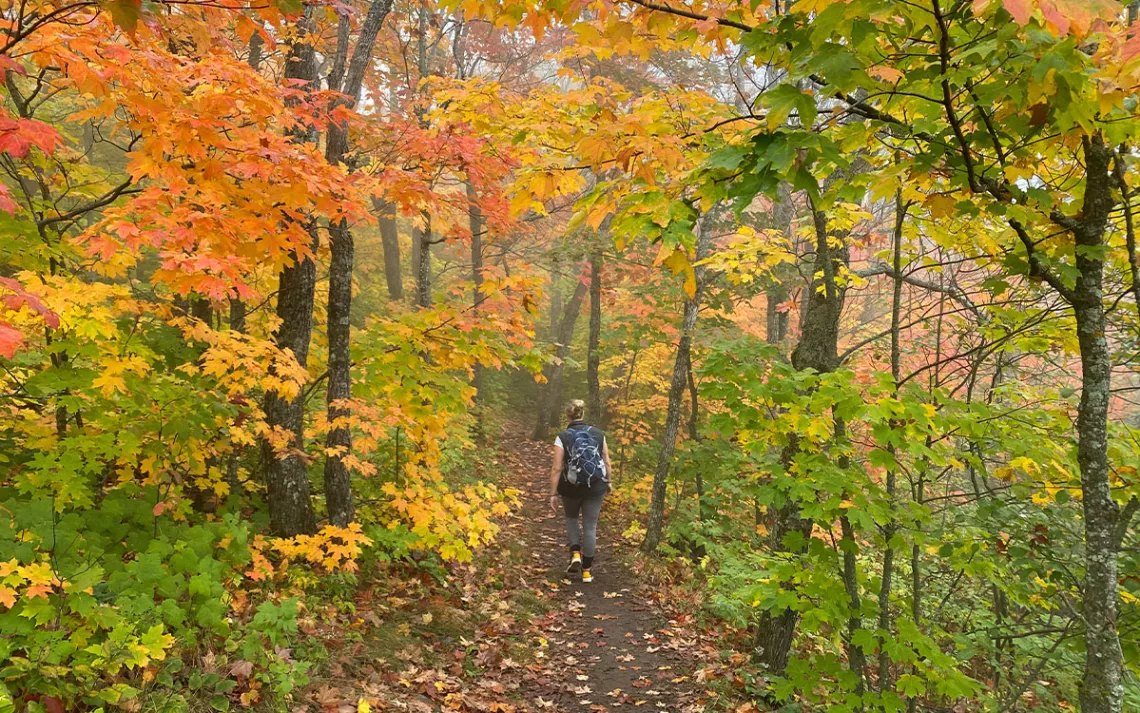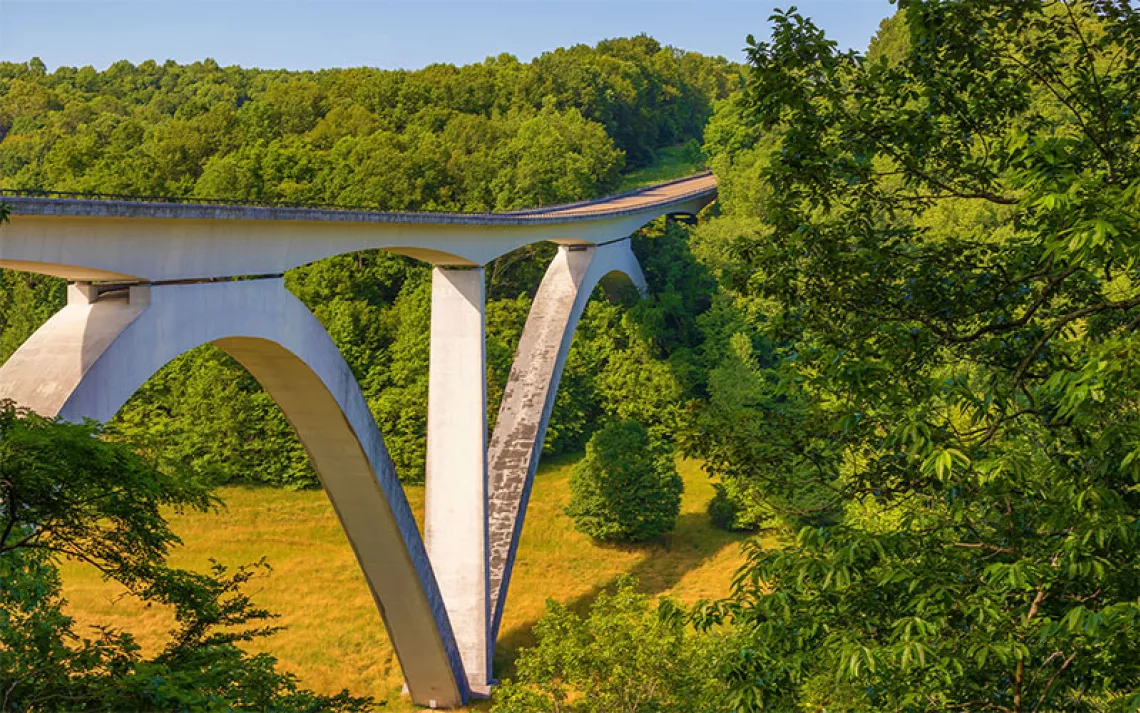Leaf-Peeping for Hikers
Here’s where trekkers should head for fabulous fall foliage

Hiking in Minnesota.
While hiking is a wonderful year-round activity, winter can be too cold and snowy, spring can be too wet and muddy, and summer can be too hot and humid. But in fall, temperatures are cooler, the mosquitoes are fewer, and fiery fall foliage turns otherwise ordinary landscapes into picture-perfect postcard material.
Here are some heavenly hiking destinations where you will also find fall foliage at its finest.
Minnesota’s North Shore
Much of this Midwestern state is blanketed with a vivid canvas of rich oranges and brilliant yellows each autumn, but for the best (and most densely concentrated) fall foliage, head to the northeastern corner of Minnesota. The 154-mile North Shore Scenic Drive running along the coast of Lake Superior doesn’t just make for a scenic road trip; it also offers a seemingly endless number of hiking hot spots along the way.
A whopping eight state parks are situated right along the main road, Highway 61, each offering a different trekking experience. Gooseberry Falls State Park takes hikers along huge waterfalls and through dense coniferous forests, while Tettegouche State Park guides hikers along steep and jagged coastline trails with views that resemble those of Maine’s much more crowded Acadia National Park. The North Shore’s Split House Lighthouse State Park also provides free all-terrain track chairs (electric-powered motorized wheelchairs) that visitors can use on trails.
New York’s Adirondack Park
Upstate New York’s Adirondack Park, typically referred to simply as “the Adirondacks,” is a National Historic Landmark that is pretty much New York’s version of a national park. The park’s sprawling 6 million acres make it the largest publicly protected area in the contiguous United States, and its handsome hamlets and tiny towns make it a great base for autumn hiking. Lake Placid tends to attract the most crowds because of its vibrant downtown area and its proximity to some of the Adirondack’s 46 high peaks.
However, if you want the misty mountain views and fiery fall foliage that you’ve seen on social media—without the crowds—head to the quieter eastern section of the Adirondacks known as the Lake Champlain region. The Champlain Area Trail System (known as CATS) has trails that are quieter and less intense than those found in the high peaks, with some venturing up mountains and others lazily wandering across lovely lakes and farmers’ fields. Their handy trail finder map displays trail options, describes the terrain, and provides directions to hard-to-find trailheads.

South Carolina’s Upcountry
South Carolina’s coastal cities of Charleston and Myrtle Beach tend to hog a lot of the state’s attention, thanks to their wealth of history, beaches, culture, and comfort food. But when it comes to pristine nature, the upcountry is calling. In this northwestern corner of the state, mountains, lakes, waterfalls, and foothills welcome you year-round, but especially in fall, when various shades of green turn to brilliant reds, yellows, and orange. At Table Rock State Park, yellow beech, red tupelo, and black gum trees populate the forest, providing a kaleidoscope of color to hikers climbing nearly 2,400 feet up the Table Rock Trail to reach even more impressive views on the mountaintop. To make this 7.2-mile trek even harder (and more rewarding), tack on a couple of extra miles and a few more hundred feet of elevation by detouring to Pinnacle Mountain before making your way back down. Several less-strenuous trails also wander through the park, including the picturesque Lakeside Trail, a two-mile loop around Pinnacle Lake.
Just 15 minutes from Table Rock State Park, you’ll find Keowee-Toxaway State Park, where a network of short- and long-distance trails collide so you can choose the trek length of your choosing. Whatever you select, consider adding on the Raven Rock Trail, a moderate to strenuous four-mile loop that meanders through enormous cypress and loblolly pine forests as it makes its way to the waterfront.

Sign up to receive Sierra News & Views
Get articles like this one sent directly to your inbox weekly.
With this action you affirm you want to receive Sierra Club communications and may vote on policy designated by the Sierra Club Board.
Colorado
Hiking hot spots abound across this stunning state, with some of the most impressive fall foliage gracing the forests of the state’s numerous national parks, like the ever-popular Rocky Mountain National Park. However, while much of Colorado offers prime peeping during leaf season, keep in mind that much of this mountainous state sits at elevations so high that the peak fall foliage occurs in late September and early October.
If you’re looking for brilliant colors later in the season, consider heading toward the Grand Mesa, about 90 minutes east of Grand Junction. Here, you’ll find energizing breezes, earthy scents, and a dizzying array of colors. The Crag Crest Trail is a great pick, a strenuous 11.3-mile hike (with 1,548 feet of elevation) that takes you up along a narrow ridge with steep drops down both sides. As you climb, take in the expansive views of dazzling autumn colors reflecting off of mirror-like lakes, backdropped by towering mountains in the distance.
Western Wyoming
Wyoming offers some of the most spectacular fall hiking experiences, including at its claim to fame, Grand Teton National Park. The quaking aspens and narrowleaf cottonwoods turn brilliant shades of yellow and gold as the sky-high mountains reflect off the park’s famous network of lakes. Trails like the Cascade Canyon and Jenny Lake Loop provide breathtaking views of the Teton Range while meandering through picturesque forests and alongside serene lakes. However, these trails aren’t exactly a secret and they can get very busy, so visiting early in the morning and on weekdays can provide a quieter experience. Additionally, while the southwestern section of the Jenny Lake Loop receives a lot of visitors, the harder-to-reach northeastern section (and its additional loop extensions) attract far fewer people so intermediate and advanced hikers could consider tackling those.
In general, the northern part of the park receives fewer visitors than the south, but you’ll find similarly stunning landscapes, though the dense forests sometimes hide views of the Teton Range. Keep in mind that wherever you go in the park, you’ll still be in grizzly bear country, so it’s wise to hike with a buddy and to bring bear spray along.
 The Magazine of The Sierra Club
The Magazine of The Sierra Club



